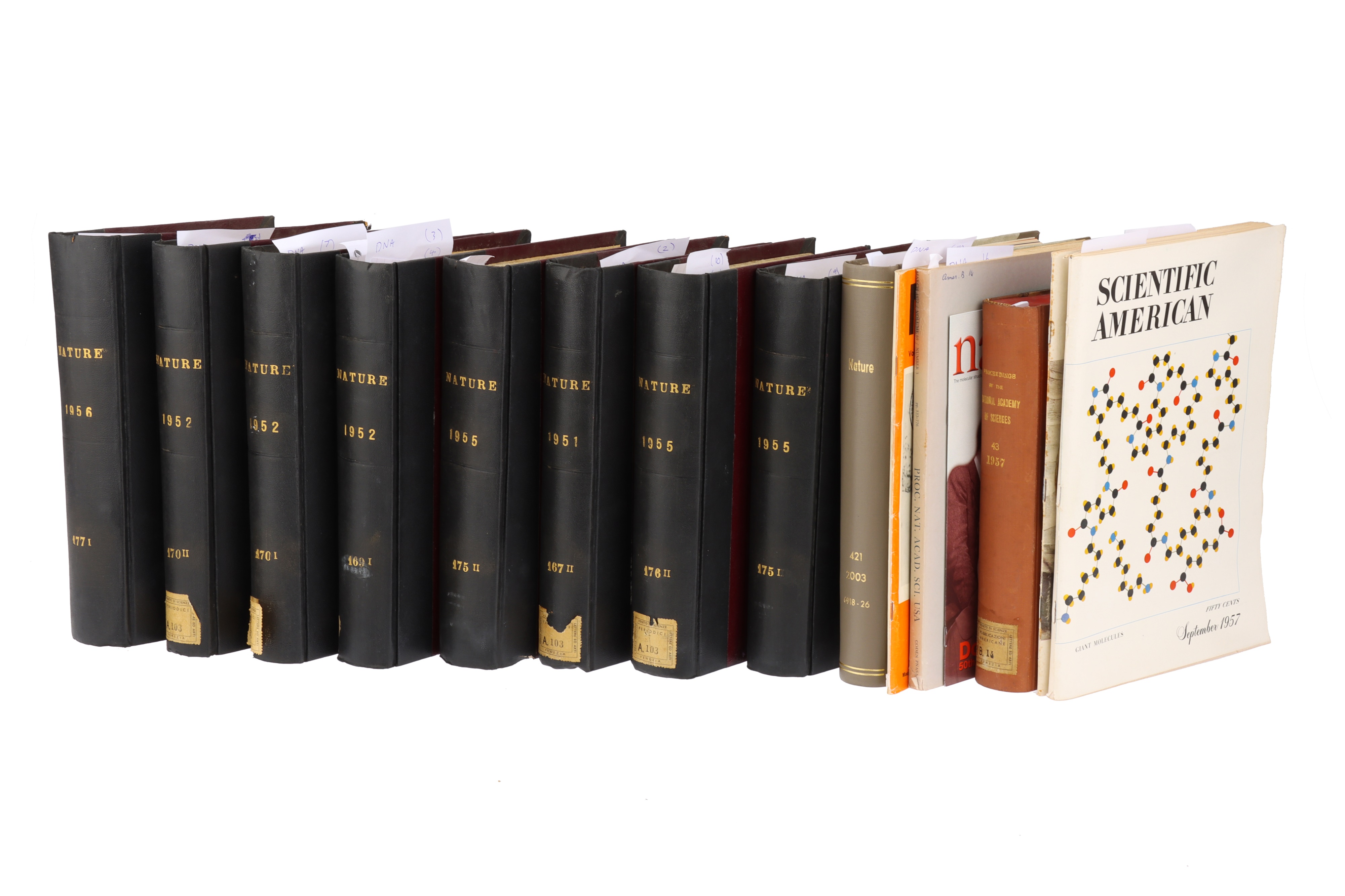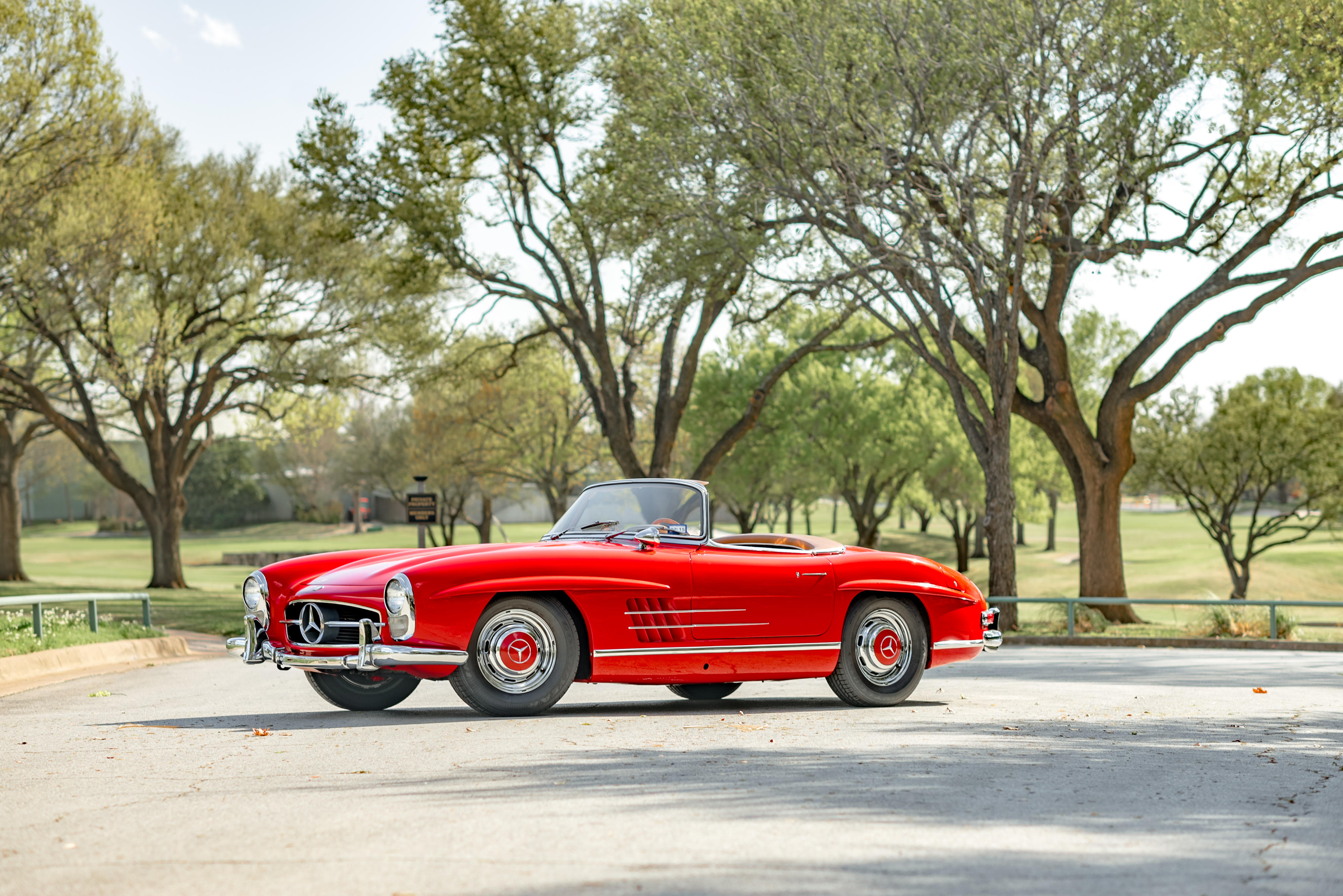3 classic articles that founded modern genetic science:
1. WATSON, JAMES DEWEY, and FRANCIS HARRY COMPTON CRICK, et al. 1916-2004. "Molecular Structure of Nucleic Acids." IN: Nature, Volume 171, No 4356, April 25, 1953. London: Macmillan & Co., 1953. Complete issue, lacking original printed wrappers.
2. WILKINS, M.H.F., et al. "Helical Structure of Crystalline Deoxypentose Nucleic Acid." FROM: Nature, Volume 172, No 4382, October 24, 1953. [London: Macmillan & Co., 1953.] Excerpt, pp 759-762. Loose, on 2 leaves, recto and verso.
3. CRICK, FRANCIS HARRY COMPTON, et al. "General Nature of the Genetic Code for Proteins." IN: Nature, Volume 192, No 4809, December 30, 1961. [London: Macmillan & Co., 1961.] Complete issue, lacking original wrappers, re-bound in marbled paper.
All three contained in an archival card chemise laid into cloth-backed board portfolio.
ORIGINAL PUBLICATIONS THAT BEGAN THE UNDERSTANDING OF GENETIC CODE. Cambridge graduate student Francis Crick and research fellow James Watson enjoy the distinction of publishing the first article identifying and describing DNA. While they spent time developing a physical model to create an accurate picture of the molecule, their competitors at King's College, London, Maurice Wilkins and Rosalind Franklin, were involved in equally important research looking at x-ray diffraction images of DNA. Wilkins showed Franklin's research to Watson and Crick—apparently without her knowledge—which led the Cambridge team to suggest that the DNA molecule was made up of two chains of nucleotides, each a helix, one going up and one going down. Their model at last provided an explanation of the way DNA separates and replicates during cell division. Of these 3 foundational articles, the first paper, by Watson and Crick, identifies the double helix structure of DNA. The second paper by Wilkins, Stokes, Seeds and Wilson explains how the structure divides before mitosis so that each strand can act as a cell. The third is a later paper by Crick, Leslie Barnett, S. Brenner and R.J. Watts-Tobin, which describes a series of genetic experiments which proved that the genetic code for protein was a triplet code.
3 classic articles that founded modern genetic science:
1. WATSON, JAMES DEWEY, and FRANCIS HARRY COMPTON CRICK, et al. 1916-2004. "Molecular Structure of Nucleic Acids." IN: Nature, Volume 171, No 4356, April 25, 1953. London: Macmillan & Co., 1953. Complete issue, lacking original printed wrappers.
2. WILKINS, M.H.F., et al. "Helical Structure of Crystalline Deoxypentose Nucleic Acid." FROM: Nature, Volume 172, No 4382, October 24, 1953. [London: Macmillan & Co., 1953.] Excerpt, pp 759-762. Loose, on 2 leaves, recto and verso.
3. CRICK, FRANCIS HARRY COMPTON, et al. "General Nature of the Genetic Code for Proteins." IN: Nature, Volume 192, No 4809, December 30, 1961. [London: Macmillan & Co., 1961.] Complete issue, lacking original wrappers, re-bound in marbled paper.
All three contained in an archival card chemise laid into cloth-backed board portfolio.
ORIGINAL PUBLICATIONS THAT BEGAN THE UNDERSTANDING OF GENETIC CODE. Cambridge graduate student Francis Crick and research fellow James Watson enjoy the distinction of publishing the first article identifying and describing DNA. While they spent time developing a physical model to create an accurate picture of the molecule, their competitors at King's College, London, Maurice Wilkins and Rosalind Franklin, were involved in equally important research looking at x-ray diffraction images of DNA. Wilkins showed Franklin's research to Watson and Crick—apparently without her knowledge—which led the Cambridge team to suggest that the DNA molecule was made up of two chains of nucleotides, each a helix, one going up and one going down. Their model at last provided an explanation of the way DNA separates and replicates during cell division. Of these 3 foundational articles, the first paper, by Watson and Crick, identifies the double helix structure of DNA. The second paper by Wilkins, Stokes, Seeds and Wilson explains how the structure divides before mitosis so that each strand can act as a cell. The third is a later paper by Crick, Leslie Barnett, S. Brenner and R.J. Watts-Tobin, which describes a series of genetic experiments which proved that the genetic code for protein was a triplet code.





.jpg)
.jpg)



.jpg)

.jpg)
.jpg)
.jpg)
Testen Sie LotSearch und seine Premium-Features 7 Tage - ohne Kosten!
Lassen Sie sich automatisch über neue Objekte in kommenden Auktionen benachrichtigen.
Suchauftrag anlegen